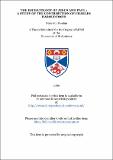The eschatology of Jesus and Paul : a study of the contribution of Charles Harold Dodd
Abstract
An understanding of the New Testament's teaching on eschatology is vital to our understanding of the New Testament. This awareness of the importance of eschatology in New Testament interpretation received considerable attention towards the end of the nineteenth and the beginning of the twentieth century. This growing awareness owed a great deal to the works of two New Testament scholars - A. Schweitzer and C.H. Dodd. Both men gave absolute priority to the significance of eschatology in understanding the New Testament's teaching, and especially that of Jesus and Paul. Despite their agreement on the importance of eschatology as the framework within which the teaching of Jesus and Paul and the New Testament generally are to be understood, Schweitzer and Dodd varied considerably in their interpretations of New Testament eschatology, and especially that of Jesus. This thesis is concerned mainly with Dodd's 'realised' exposition of Jesus' and Paul's eschatology. The writer thinks that it is only through a very clear and close understanding of Dodd's thesis, its origin, development and growth, the motivations behind the scholar's interpretation, the ethical implications of his thesis, the closeness between Jesus' and Paul's teaching implied by Dodd's thesis, and also its continued Influence on subsequent scholarship on the subject, that Dodd's work on eschatology will be more fully appreciated. This work showed that Dodd's thesis of 'realised eschatology' for both Jesus and Paul was original and peculiar to the scholar. However, at the same time research shows that Dodd was also indebted to the works of men like A. von Harnack, E. von Dobschutz, A. Deissmann, and R. Otto, whose interpretations, expositions, and exegetical notes he used in support of his thesis. What Dodd had borrowed from these earlier Continental scholars was used only as means for achieving his goal. None of these so-called predecessors of Dodd had anticipated the 'realised eschatology' of Jesus and Paul in the manner that Dodd did. Dodd's writings showed that his initial work on Paul had brought him face to face with the reality that what has been anticipated for in the future is now fully realised in the events of the life, death, and resurrection of Jesus. It seems most likely therefore that Dodd already had developed a realised exposition of Paul's teaching before his book The Parables of the Kingdom. T.F. Glasson and J.A.T. Robinson have always been associated with Dodd's thesis of 'realised eschatology', however, as the conclusion pointed out, they did not make much extension and advancement to Dodd's initial thesis of 'realised eschatology'. T.F. Glasson was more concerned with the origin of the Parousia idea. Robinson, inasmuch as he upholds the presence of the Kingdom of God and salvation in the teaching of Jesus and Paul, at the same time allows room for a future aspect of eschatology, an aspect which Dodd in his initial thesis shunned completely. Thus it seems that in his thesis of 'realised eschatology', Dodd stands alone. Though many scholars before and after him have agreed to the presence of the element of 'realised eschatology' in the teachings of Jesus and Paul, yet none has emphasised it to the extent that Dodd did. Thus Dodd's main contribution therefore lies in this part of New Testament eschatological interpretation which to a large extent was ignored by the 'consistent' school of interpretation of A. Schweitzer.
Type
Thesis, MPhil Master of Philosophy
Collections
Items in the St Andrews Research Repository are protected by copyright, with all rights reserved, unless otherwise indicated.

